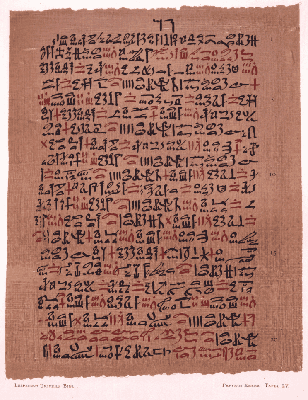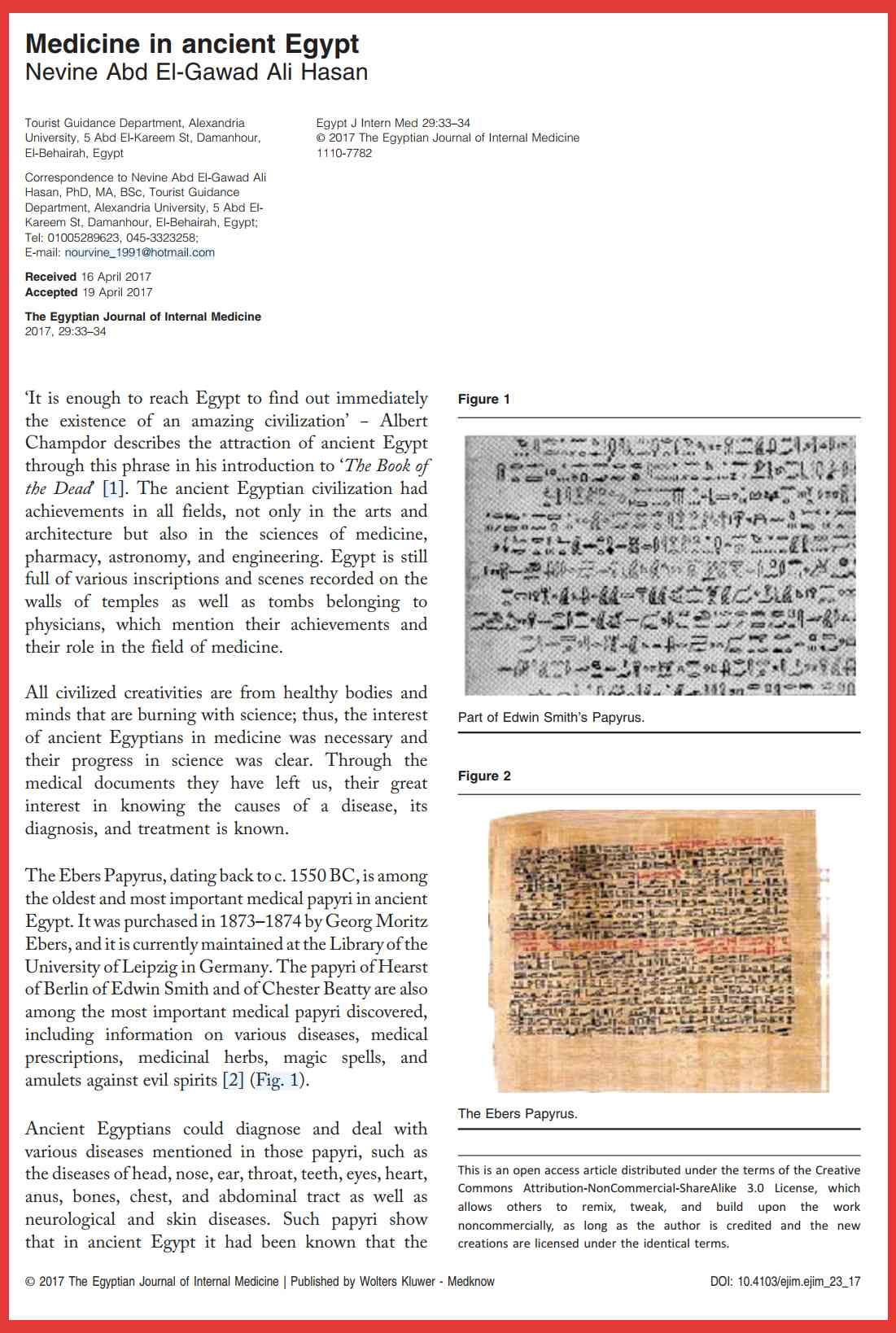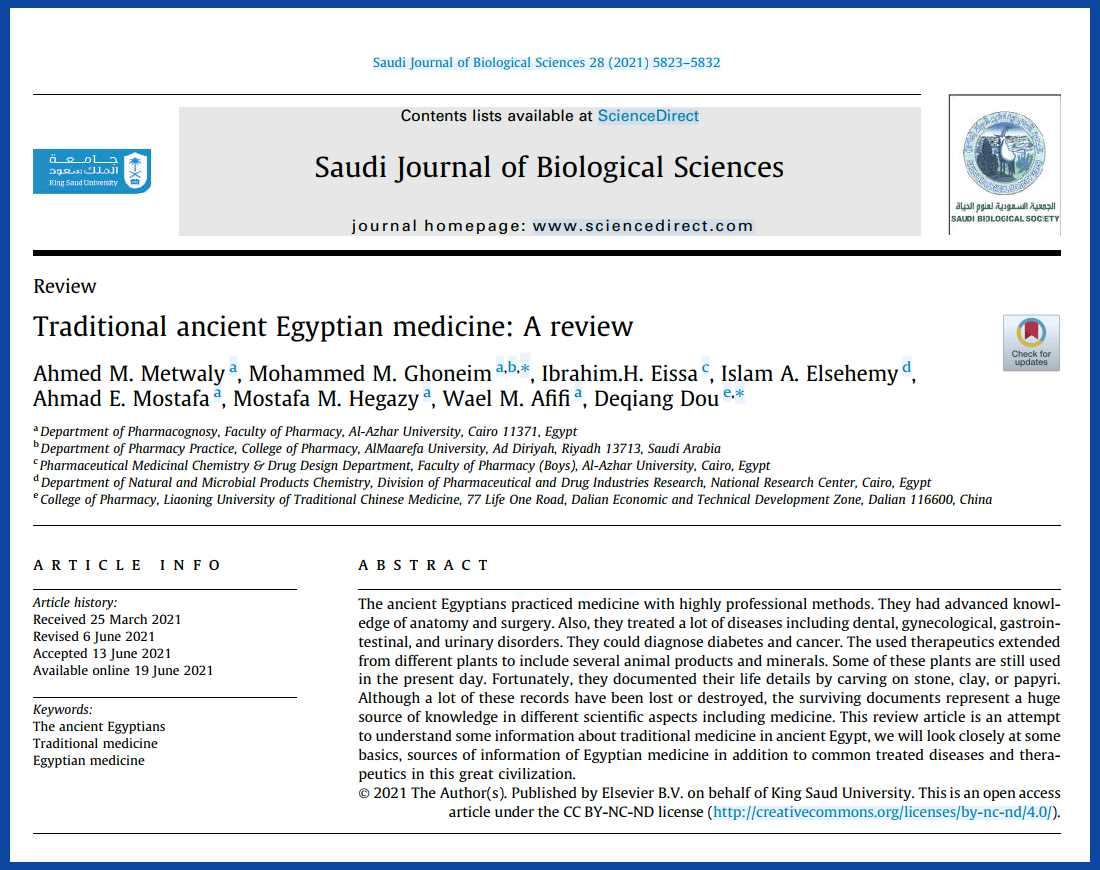Egyptian Medicine
The medicine of ancient Egypt was made from a vast array of plants and other materials that are now recognized as having pharmaceutical properties. For example, raw garlic was used extensively due to its allicin content. Just one of its many uses was keeping asthma under control. A willow and myrtle concoction was used to ease inflammation and joint pains, an extremely early precursor to the use of salicin as it is used today in aspirin. Other plants and minerals used include chickpeas, clover, cannabis, endive, iris, mustard, rose, rosemary, thistle, asparagus, eggs, liver, hair, wax, cumin, fennel, aloe, castor oil, and feces.
Ancient Egyptians had detailed knowledge of human anatomy because of their practice of making mummies. Part of the process of mummification is to remove and preserve internal organs from the dead bodies. This practice allowed the Egyptians to gain a better understanding of the human body compared to other cultures at similar time because some of the cultures frowned on dissection of dead human bodies. As an example, the ancient Egyptians placed the heart at the center of a network of vessels, the “mtw” vessels, which delivered fluids to various body parts. Functioning as a transportation system, the mtw-vessels conveyed air from the lungs and food nutrients from the gastrointestinal tract through the rest of the body. This network was considered to be integral to the health of the body. As a result, ancient Egyptians believed that feeling the pulse was particularly important because it carried information from the heart. Instructed to feel for the pulse with their fingers, student physicians would “measure the work of the heart.” The Egyptian understanding had many similarities to the current knowledge of the cardiovascular system.
The earliest document on Egyptian medicine is called the “Kahun Gynaecological Papyrus.” Dated to around 1800 BCE, it deals with women's health—gynaecological diseases, fertility, pregnancy, contraception, etc. But this is not the oldest medical document in the world – it is a Sumerian medical clay tablet from 3rd millennium. The Kahun Gynaecological Papyrus is divided into thirty-four sections, each section dealing with a specific problem and containing diagnosis and treatment. Treatments are non-surgical, comprising applying medicines to the affected body part or swallowing them.
Birth control was socially and religiously acceptable and taught by midwives. The Kahun Gynecological Papyrus lists several recipes for internally inserted contraceptives. The instructions contained ingredients such as natron, which was a type of salt found in various Egyptian lakes, acacia gum, sour milk, and crocodile dung. All contain spermicidal properties. The natron worked as a desiccant. The sour milk contributed lactic acid. And the acacia gum contained triterpene saponins. Even the crocodile dung, which several modern researchers suggest worked best as a partner deterrent, was somewhat alkaline. Higher alkalinity is a component of modern spermicides.
A picture of a section of the Kahun Gynaecological Papyrus is shown below:

A slightly later document, called the Ramesseum Papyri, is a collection of ancient Egyptian medical documents found in the temple of the Ramesseum and is dated to around 1700 BCE. Like other medical papyri from Egypt, the text explains diseases, anatomy, and suggests possible remedies. The papyri include information on childhood diseases, ophthalmological ailments, muscles, tendons, and gynecology. The manuscript was numbered in parts from III to V. Below is a section of Ramesseum Papyrus III:

Papyrus III discusses the eruption of a volcano, which was probably on Santorini (an island currently part of Greece). It explains medical problems related to burned bodies. Moreover, it describes possibilities on how to help the people who suffered from this event. As an example of treatment, a translation of one treatment reads as follows: " A treatment for the eyes: celery; hemp is ground and left in the dew overnight. Both eyes of the patient are to be washed with it early in the morning."
Papyrus IV describes gynecological issues. It is very similar to the above-mentioned Kahun Gynecological Papyrus. The text explains problems in labor, newborn babies, and has a contraception formula. Apart from this, it discusses how to predict a baby’s gender. Finally, Papyrus V explains the ways for people to relax their limbs.
Another document, called the “Ebers Papyrus” is an Egyptian medical papyrus of herbal knowledge dating to around 1550 BCE. It is a 110-page scroll, which is about 20 meters long. Examples of remedies in the Ebers Papyrus include:
(1) Birth control: "To prevent conception, smear a paste of dates, acacia, and honey to wool and apply as a pessary."
(2) Diabetes mellitus: "Drink a mixture including elderberry, asit plant fibres, milk, beer-swill, cucumber flowers, and green dates."
(3) Asthma: A mixture of herbs heated on a brick so that the sufferer could inhale their fumes.
(4) Belly: "For the evacuation of the belly: Cow's milk 1; grains 1; honey 1; mash, sift, cook; take in four portions."
(5) Bowels: "To remedy the bowels: Melilot, 1; dates, 1; cook in oil; anoint sick part."
The Ebers Papyrus also states that “yeast of sweet beer” was a wound remedy. Currently, it ranks as the first documented account of yeast used as an antibiotic. In addition, moldy bread was one of a multitude of remedies used to treat infections in ancient Egypt. While moldy bread would have been a risky procedure and would not have created penicillin of the genus currently used as an antibiotic, it may have grown a species of fungus in the penicillin family, depending on the type of bread that it grew upon. As with many folk remedies, many questions about efficacy and safety have yet to be answered.
The Ebers Papyrus contains several recipes for curing impotence, and several of the mixtures may have helped. For example, carob is a common ingredient and has high levels of histamine. Mice with low histamine levels have exhibited decreased mating.
The scroll also contains some 700 magical formulas and folk remedies. It includes many spells meant to turn away disease-causing demons. A picture of a section of the Ebers Papyrus is show below:

A chapter of the Ebers Papyrus on diseases of the eyes can be downloaded below.
Another document is called the “Edwin Smith Papyrus.” It is dated to the Second Intermediate Period, around 1600 BCE, and is the oldest known surgical treatise on trauma. This document describes 48 cases of injuries, fractures, wounds, dislocations and tumors. The papyrus is unique among the principal medical papyri in existence that survive today: while other papyri, such as the Ebers Papyrus, are medical texts with religious overture, the Edwin Smith Papyrus presents a rational and scientific approach to medicine in ancient Egypt. A picture of a section of the Edwin Smith Papyrus is shown below:

A translation of part of the papyrus can be downloaded below.
One aspect of Egyptian medicine that was different from many cultures was that many Egyptian physicians specialized in an area of medicine. Inscriptions on tombs and the medical papyri show that there were neurologists, ophthalmologists, dentists, gastroenterologists, proctologists, and internal medicine. Some doctors had more than one specialty. One highly accomplished physician was Ir-en-akhy. His tomb announces that he was an eye doctor, a gastroenterologist, an “interpreter of liquids,” and a “shepherd of the anus.”
Below are a few publications on Egyptian medicine:
(1) The Diseases of the Eyes chapter of a book titled Ancient Egyptian Medicine - The Papyrus Ebers

(2) The Edwin Smith Surgical Papyrus

(3) Orthopedic surgery in ancient Egypt


(5) Traditional ancient Egyptian medicine: A review

(6) Psychiatry in Ancient Egypt
